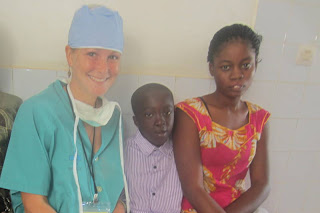I have to admit: I was starting to feel sheepish about having divulged my med school ambitions to too many people; I started wanting to back out as I came to terms with the mountain of prerequisites that I would have to face after leaving Peace Corps this spring. Then… something happened – I got a call asking me to translate for American doctors coming to Senegal to repair cleft lips and pallets. I was feeling pushed and pulled in all different directions, wanting to be in my village for a stretch, knowing my friend Kayla would soon be coming to visit from America… but I couldn’t pass up the opportunity. And for Pete’s sake, I can’t believe I almost said no. It was entirely life-changing.
We’ve all see those commercials about the “Smile Trains” – the Western doctors that come into developing countries to operate on hair-lipped kids. Being a part of it, however, really drove home the importance and wonder of what occurs.
From start to finish, I was blown away by what was transpiring before my eyes and by what I got to be a part of. The team from the Global Smile Foundation worked with a group of local doctors at a hospital in Thies, operating on 30 people from the ages of 5 months to 25 years, all with unilateral or bilateral cleft lips or pallets. The job of the PCVs in attendance – myself and four others—was to do English/Wolof/French translation and whatever other odd jobs the American doctors were in need of. Right after I arrived the first morning, my first task was to help one of the head surgeons talk to a seven-year-old patient, Awa, and her TWIN SISTER, Ada. Dr. Farid said, “Tell her that after the operation, she’s going to look just like her sister.” What a beautiful , thrilling, once-in-a-lifetime experience that was, to be able to tell a little girl that these doctors would change her and make her look like her twin. They both smiled, shyly.
Things only got more incredible from there. They let me into the Operating Room almost immediately. The American doctors were all really good people, each one kinder, more patient, and more eager to teach than last. The first operation I watched was on that 7-year-old girl with a complete cleft lip. Once the anesthesiologists had put her under, Dr. Kyle and Dr. Ousama made markings on the girl’s upper lip and discussed where to cut before they injected anesthetic “pain blocks” into her face, which caused her lip to swell dramatically. (Babies and children were all put to sleep, but anyone 12-years-old and up was counted as an “adult” and therefore put under local instead of general anesthesia.)
Fifteen minutes later, once the pain block injections had fully kicked in, they went to work. Incisions were made, skin was snipped, and they moved along deftly and expertly. And then, not too long after that, the first stitch was made, pulling the two parts of the upper lip together. All of a sudden, this startling, miraculous thing occurred: the girl’s face was whole, and it was changed. The doctors were done before I knew it, and that was that: one hour had passed since they had injected her anesthesia, and now she was waking up, looking around the room, sitting up on the OR table, and getting ready to move to the recovery room. And, essentially, she had a new face. I was speechless. Literally! I NEVER hurt for words. But I was bereft of words that could come close to articulating the awe that was swirling through my mind.
The work that occurred in those 60 minutes, throughout the day, and for the duration of the four days of the surgical mission continued to blow the mind. I got to talk to adult patients, comfort them during surgery, hold babies, assuage the fears of parents, hear stories about why they thought their children had been born with this deformity, clean surgical implements, assist surgeons in all sorts of ways, and generally observe and participate in some seriously fascinating and touching operations. The lives of some of these people, who had come from village and towns all around Senegal to have the operation, composed sad vignettes, and talking to them was eye-opening. There was one young women who said that she had had to pay someone to marry her; another girl simply said that she would never have been able to get married if the was not to have the surgery. I got to spend a lot of time with a little 10-year-old boy named Abdou, whose entire persona screamed of his intelligence, kindness, pure integrity, and fervor for life. Unfortunately, he also had a severe cleft lip, and while he had tried to go to school twice when he was younger, he was kicked out by his teacher both times because he was not able to speak clearly. (Cleft lip surgery addresses issues that are far beyond aesthetic – most kids that don’t have the issue fixed as an infant develop major speech defects.) Over and over again, myself and the other volunteers found ourselves incredulous at both the stories that these peole were telling us and the candor with which they told them.
If I was looking for affirmation for my post-Peace Corps goals, I certainly found it, in spades.
 |
| Dr. Sarah Jane doing last minute checks on a patient. |
 |
| Little baby on the OR table! |
 |
| Bringing in the next patient. |
 |
| Justin and I in the OR. |
 | |
| A Haitian patient pre-surgery. |
 |
| Abby with a patient and her family - mother, big sister, baby sister, and grandma - after surgery. |




Yes! Very cool.
ReplyDelete